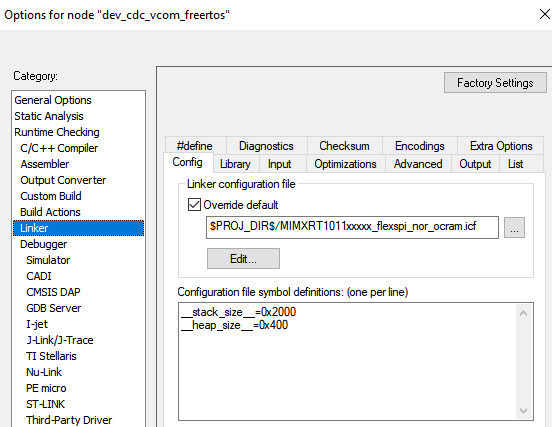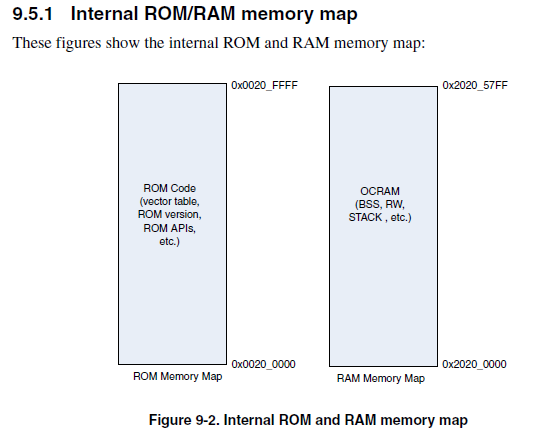IVT里的不同entry设置可能会造成i.MXRT1xxx系列启动App后发生异常跑飞问题的分析解决经验
本文转载于痞子衡嵌入式,原文:https://www.cnblogs.com/henjay724/p/13652875.html
事情缘起恩智浦官方论坛上的一个疑问帖 《RT1015 dev_cdc_vcom_freertos reset entry failed》,这是客户QISDA遇到的问题,由痞子衡的同事 - 非常细心负责的Kerry小姐姐将问题整理出来并发了贴,帖子里做了详尽的问题描述以及各种测试结果。看完长帖后,痞子衡第一猜想就是跟App栈设置有关,最终也确实是这个原因。那么为什么栈设置会出问题呢?且听痞子衡细聊:
一、问题描述
让我们先来整理一下帖子里的问题现象,客户在RT1015-EVK上测试了恩智浦官方SDK里的两个例程,一个是简单的hello_world,另一个是复杂的dev_cdc_vcom_freertos,这两个例程在不同IDE、IVT中entry值组合下现象不一致:
| 测试App | IVT中entry | 测试IDE | App运行结果 |
|---|---|---|---|
| hello_world | 中断向量表起始地址/ 复位向量函数地址 | IAR EWARM/ MCUXpresso IDE | 正常 |
| dev_cdc_vcom_freertos | 中断向量表起始地址 | IAR EWARM/ MCUXpresso IDE | 正常 |
| dev_cdc_vcom_freertos | 复位向量函数地址 | IAR EWARM | 正常 |
| dev_cdc_vcom_freertos | 复位向量函数地址 | MCUXpresso IDE | 异常跑飞 |
根据上表结果,其实我们很难得出一个有效推论,只能说这个异常结果在特定的App, entry值, MCUXpresso IDE下才能复现。
二、原因探究
既然暂时看不出原因,那我们先做一些准备工作吧。我们把三个影响因子(App, entry值, IDE)的差异先整理出来:
2.1 两个App的不同链接分配
两个App都来自SDK,是经过官方详尽测试的,所以我们不去怀疑App本身的功能异常。它们的差异主要在链接分配上。以IAR为例,我们只看flexspi_nor build,在链接文件中默认分配的堆、栈大小均为1KB:
/* Sizes */
if (isdefinedsymbol(__stack_size__)) {
define symbol __size_cstack__ = __stack_size__;
} else {
define symbol __size_cstack__ = 0x0400;
}
if (isdefinedsymbol(__heap_size__)) {
define symbol __size_heap__ = __heap_size__;
} else {
define symbol __size_heap__ = 0x0400;
}hello_world例程因为比较简单,所以用直接用了默认的堆栈大小,而dev_cdc_vcom_freertos例程比较复杂,堆栈做了额外调整,栈增大到了8KB。

此外我们还注意到hello_world例程将其RW, ZI, 堆栈全部放进了32KB的DTCM;而dev_cdc_vcom_freertos例程则将RW, ZI放入了64KB OCRAM,只将堆栈放进了DTCM:
define symbol m_data_start = 0x20000000;
define symbol m_data_end = 0x20007FFF;
define symbol m_data2_start = 0x20200000;
define symbol m_data2_end = 0x2020FFFF;
define region DATA_region = mem:[from m_data_start to m_data_end-__size_cstack__];
define region DATA2_region = mem:[from m_data2_start to m_data2_end];
define region CSTACK_region = mem:[from m_data_end-__size_cstack__+1 to m_data_end];
// 适用hello_world例程
place in DATA_region { block RW };
place in DATA_region { block ZI };
place in DATA_region { last block HEAP };
place in DATA_region { block NCACHE_VAR };
place in CSTACK_region { block CSTACK };
// 适用dev_cdc_vcom_freertos例程
place in DATA2_region { block RW };
place in DATA2_region { block ZI };
place in DATA_region { last block HEAP };
place in DATA_region { block NCACHE_VAR };
place in CSTACK_region { block CSTACK };2.2 entry值在BootROM中的使用
再说IVT中的entry,痞子衡在i.MXRT1xxx系列启动那些事系列文章中的 《Bootable image格式与加载》 的3.2节介绍过IVT结构以及其作用,IVT是关键启动头,指导了BootROM去搬移App以及加载执行,其中entry成员主要用于跳转执行。
为什么这个entry值既可以是中断向量表(Vector Table)起始地址也可以是复位向量(Reset_Handler)函数地址呢?这取决于BootROM中是怎么利用这个entry值的,下面函数即是BootROM中最终跳转函数:
void jump_to_entry(uint32_t entry)
{
typedef void (*application_callback_t)(void);
static application_callback_t s_app_callback;
pu_irom_mpu_disable();
__DMB();
__DSB();
__ISB();
// The entry point is the absolute address of the call back function
if ((uint32_t)entry & 1)
{
s_app_callback = (application_callback_t)entry;
}
// The entry point is the base address of vector table
else
{
static uint32_t s_stack_pointer;
// Ensure Core read vector table for destination instead of register
volatile uint32_t *vector_table = (volatile uint32_t *)entry;
s_stack_pointer = vector_table[0];
s_app_callback = (application_callback_t)vector_table[1];
// Update Stack pointer
__set_MSP(s_stack_pointer);
__set_PSP(s_stack_pointer);
}
__DSB();
__ISB();
// Jump to user application in the end
s_app_callback();
// Should never reach here
__NOP();
__NOP();
}从上面的跳转函数jump_to_entry()实现可以看出,entry值如果是复位函数地址(即奇地址),那么BootROM直接跳转到复位函数执行;如果entry值是中断向量表首地址(即偶地址),BootROM会先将当前SP重设到App指定的栈顶,然后再跳转到复位函数。
好的,现在我们知道了IVT中不同的entry值差异在哪了。
2.3 不同IDE下startup流程
因为涉及到两个不同IDE,即IAR和MCUXpresso IDE,所以我们分别看一下这两个IDE下的startup实现。我们知道main函数之后的代码基本是IDE无关的,而startup却是因编译器而异。
痞子衡以i.MXRT1010的SDK2.8.2包里的例程为例,先用IAR打开其中的dev_cdc_vcom_freertos例程,找到工程下的startup_MIMXRT1011.s文件,看它的Reset_Handler实现:
__vector_tableDCD sfe(CSTACK)
DCD Reset_Handler
DCD NMI_Handler ;NMI Handler
DCD HardFault_Handler ;Hard Fault Handler
; ...
__Vectors_End
THUMB
PUBWEAK Reset_Handler
SECTION .text:CODE:REORDER:NOROOT(2)
Reset_Handler
CPSID I ; Mask interrupts
LDR R0, =0xE000ED08
LDR R1, =__vector_table
STR R1, [R0]
LDR R2, [R1]
MSR MSP, R2
LDR R0, =SystemInit
BLX R0
CPSIE I ; Unmask interrupts
LDR R0, =__iar_program_start
BX R0
IAR版本Reset_Handler主要分四步: 重设VTOR、重设SP、执行SystemInit(关看门狗,关Systick,处理Cache)、执行IAR库函数__iar_program_start(data/bss/ramfunc段初始化,跳转到main)。
再用MCUXpresso IDE打开同样的dev_cdc_vcom_freertos例程,找到工程下的startup_mimxrt1011.c文件,看它的ResetISR实现:
extern void _vStackTop(void);
__attribute__ ((used, section(".isr_vector")))
void (* const g_pfnVectors[])(void) = {
// Core Level - CM7
&_vStackTop, // The initial stack pointer
ResetISR, // The reset handler
NMI_Handler, // The NMI handler
HardFault_Handler, // The hard fault handler
// ...
}; /* End of g_pfnVectors */
__attribute__ ((section(".after_vectors.reset")))
void ResetISR(void) {
__asm volatile ("cpsid i");
SystemInit();
// Copy the data sections from flash to SRAM.
unsigned int LoadAddr, ExeAddr, SectionLen;
unsigned int *SectionTableAddr;
// Load base address of Global Section Table
SectionTableAddr = &__data_section_table;
// Copy the data sections from flash to SRAM.
while (SectionTableAddr < &__data_section_table_end) {
LoadAddr = *SectionTableAddr++;
ExeAddr = *SectionTableAddr++;
SectionLen = *SectionTableAddr++;
data_init(LoadAddr, ExeAddr, SectionLen);
}
// At this point, SectionTableAddr = &__bss_section_table;
// Zero fill the bss segment
while (SectionTableAddr < &__bss_section_table_end) {
ExeAddr = *SectionTableAddr++;
SectionLen = *SectionTableAddr++;
bss_init(ExeAddr, SectionLen);
}
__asm volatile ("cpsie i");
// Call the Redlib library, which in turn calls main()
__main();
while (1);
}
MCUXpresso IDE版本ResetISR主要分三步: 执行SystemInit(重设VTOR,关看门狗,关Systick,处理Cache)、data/bss/ramfunc段初始化、跳转到main。
经过上面对比,看出差异没有?MCUXpresso IDE相比IAR的startup少了一步重设SP的动作。
2.4 导致异常跑飞的栈错误
有了前面三节的分析基础,我们基本可以得出dev_cdc_vcom_freertos例程异常跑飞的原因是发生了栈错误。为什么会发生栈错误?这是由于MCUXpresso下的startup中没有重设SP操作,所以当IVT中的entry是复位向量时,BootROM跳转到App后依旧延用BootROM中的栈,根据芯片参考手册System Boot章节里的信息,BootROM的栈放在了OCRAM空间(0x20200000 - 0x202057FF),但是dev_cdc_vcom_freertos例程又把RW, ZI段也放进了OCRAM中,因此随着App的运行对栈的利用(函数调用、局部变量定义)有可能与App中的RW, ZI段数据(全局变量)互相破坏,程序发生未知跑飞也在意料之中。

解决问题的方法是什么?当然是在MCUXpresso IDE的startup流程中加入重设SP操作,保持与IAR startup流程一致。
__attribute__ ((section(".after_vectors.reset")))
void ResetISR(void) {
__asm volatile ("cpsid i");
/* 新增SP重设代码 */
__asm volatile ("MSR msp, %0" : : "r" (&_vStackTop) : );
__asm volatile ("MSR psp, %0" : : "r" (&_vStackTop) : );
SystemInit();
// ...
}
至此,IVT里的不同entry设置可能会造成i.MXRT1xxx系列启动App后发生异常跑飞问题的分析解决经验痞子衡便介绍完毕了,掌声在哪里~~~